Read part 1
ESTOY ENFERMO
Lima and it's neighboring cities is a very large place. So to speed things up we took a city tour of the old historic center of town. On the way we stopped at the Museo Nacional de Arqueología Antropología e Historia del Perú to look at some prehistoric artifacts. However, I wasn't feeling all that great that morning.
"
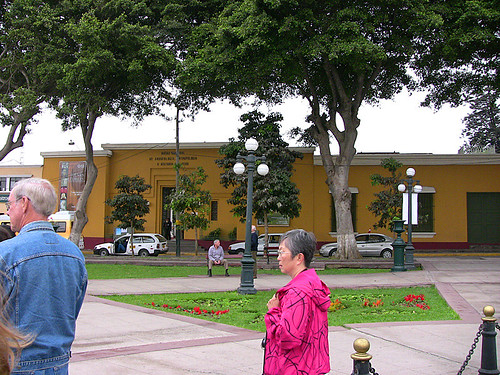
The Museo Nacional de Arqueología Antropología e Historia del Perú
I'm not sure why I was sick to my stomach. I was being careful with the water, drinking only bottled water, and hadn't eaten any raw fruit. I did have several Pisco Sours, a mixed drink made with lime juice which I learned later the lime juice can bother your stomach. Maybe it was the rich dinner of duck I had the night before. Either way my stomach was in no mood to be bounced around inside a bus with a bunch of other tourists. But I toughed up and away we went.
The museum was an old hacienda that was built around a courtyard. The displays were tucked into each of the rooms that opened up on to the walkway that bordered this yard.
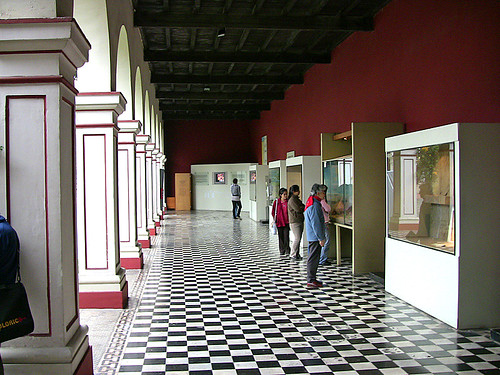
The Museum walk ways
I was starting to feel queasy again when we came upon the Raimondi Stela
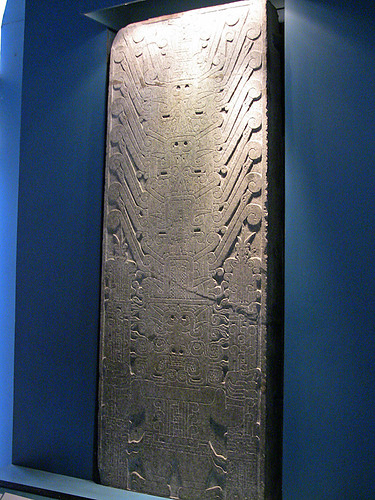
There were many time in Peru when I was brought face to face with something I read about in books, but never in my wildest dreams thought I'd ever see in person. The Raimondi Stela was the first of these encounters.
It was built by the Chavin culture. The Chavín were a civilization based in the northern Andean highlands of Peru from 900 BC to 200 BC

Stylistically, Chavín art makse extensive use of the technique of contour rivalry which allows the viewer to see different images depending upon how one looks at it. The art is supposed to be difficult to interpret, as it was intended only to be read by high priests of the Chavín cult who could understand the sacred designs. The Raimondi Stela is one of the most famous examples of this technique. At the bottom a fearsome deity stands holding two staffs and wearing a very tall headdress of snakes and other creatures. When the stela is flipped upside-down the headdress becomes a stack of fanged faces, the deity, now at the top, is now a fanged reptile, and the staffs also have faces. My photos don't do this effect justice.
The culture of the Chavin and their cultural motifs influenced many of the Peruvian prehistoric cultures that followed. At one time they where thought to be the oldest "culture" in Peru, but there is evidence of earlier cultures these days. The date for the oldest culture in Peru keeps getting pushed back, earlier in time.
There was also some great pottery from the Moche culture, who are know for their pot making skills.
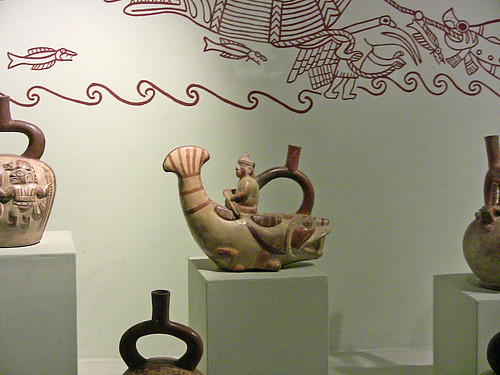
The Moche were a coastal seafaring and fishing people. This was a strong motif in the pieces we saw that day. Some of the images from pots not on display were shown on the wall behind the pottery. The image below shows a Moche fisherman. The whiskered, Dr. Seuss creature leaping to the right of the boat is a seal of some sort.

The culture of the Moche is fascinating, but too complex to go into here.
At the end of the displays came the Inca culture. There was a Quipu on display.
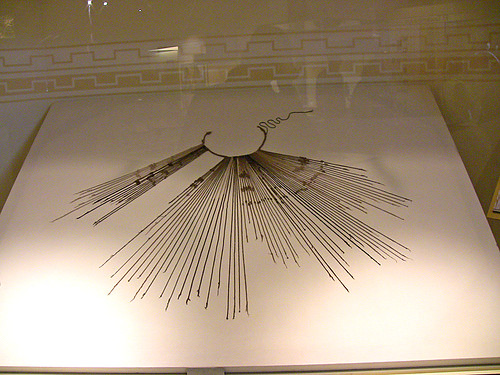
Quipu or khipu (Quechuan) were recording devices used in the Inca Empire and its predecessor societies in the Andean region. A quipu usually consisted of colored spun and plied thread from llama or alpaca hair or cotton cords, with numeric and other values encoded by a system of knots in a base 10 positional system. Some believe they were a binary system. They were not a writing system per se, but rather used to keep count or as a mnemonic device to refresh one's memory. The ability to read them was done by trained individuals called Quipucamayocs. The practice was lost during the Spanish invasion The art of the Quip[ucamayocs died out with them. Their meaning lost to the ages.
The museum also had a photo of two prehispanic Quenas. The rim blown flute of the Andes.

Photos are nice, but I would have rather seen the real instruments.
GHOSTS OF BOLIVAR
After the museum we continued to the Lima city center. We got off the bus at a big roundabout. The buildings were from the 19th century. It had been raining and everything was old and gray looking.

Of course my opinion of this part of town I'm sure was altered by how I felt, lousy, and the fact that there were tons of people around. We had been warned to be careful of pickpockets and it turns out that the day we showed up was Peruvian Independence days, so the streets were mobbed. The President of Peru was giving a speech from the Plaza de Armas, one of the main plazas, but it was not open to the public, only invited guests. Streets were closed and getting from where we were to where we wanted to be, the Plaza de Armas, was not going to happen. Even our tour guides looked nervous.
Nevertheless we walked as close as we could get to the plaza and to the restaurant where we were to have lunch, (something I was not in the mood for.) Our route took us down a street that was closed to cars for the day.
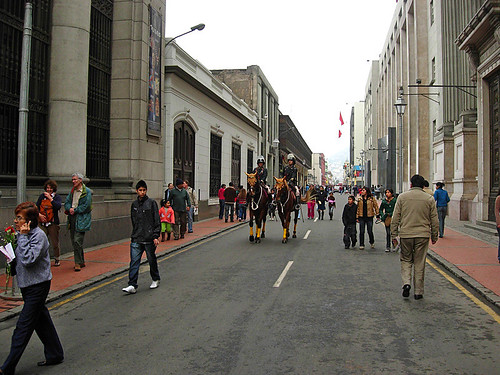
There were soldiers on horse back.

More old churches.
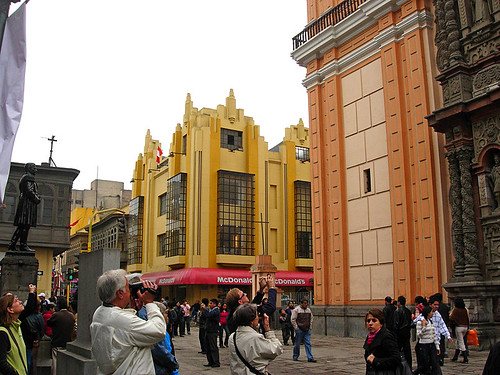
Next to the church was a cool Art Deco building that had been invaded by a fast food joint...
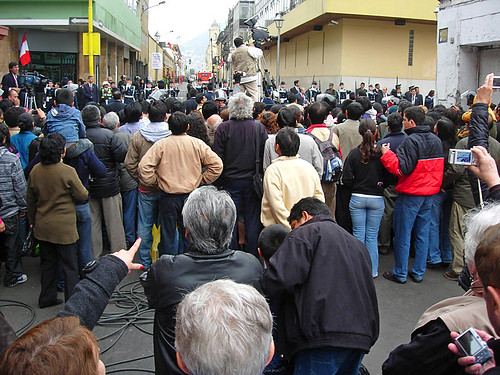
Then we came to a cross street that was completely blocked off for the motorcade of El Presidente and his guests.
We were stuck. As we waited I got my video camera out just in time to film a marching band come by on horse back. While I was filming some people in the crowd commented how much they love their El Presidente.
Click to Play
Being a guest in Peru I thought it best to not ask about these comments. Besides I was still not feeling well. Once the parade of dignitaries and soldiers passed they opened up the street and we went on our way. There were soldiers everywhere. Marching in columns, on horse back, in trucks and jeeps. Many of the uniforms of were colorful and gaudy. I began to feel like I was witnessing an 19th century coup.
We made it to the restaurant. I skipped lunch. Back at the hotel I drank chicken soup for dinner and took it easy. I began to feel better, almost normal. We watched Peruvian TV in the room, most of the programs were from the U.S. dubbed in Spanish.
LOST IN TRANSLATION
The next day we visited a fish market. By then I was feeling great and looking at all the fish was making me hungry. The local fishermen were showing off their catch. One of the fish I did not recognize so I asked our guide what it was. She didn't know either so she asked him. I caught the exchange on film. There was some confusion to say the least...
Click to Play
I think it was eel, but I"m still not sure...
That wrapped up our visit to Lima. The next day we went to the airport and flew to Cuzco in the heart of the Andes. I was glad to leave Lima behind and get to the heart and soul of Peru.
Continue to Part 3
These blogs have fabulous, Scott! I'm sure I'm not alone in my enjoyment of them. You've piqued my curiosity to Google several topics.
ReplyDeleteHi I found this doing research on Moche fishing. Nice post! Great photos of the museum.
ReplyDelete